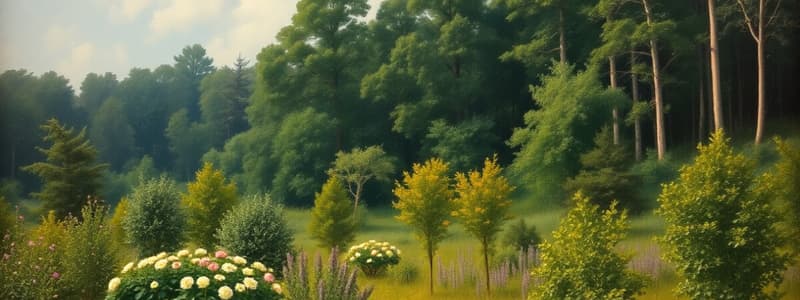Podcast
Questions and Answers
Which of the following characterizes the climax community stage in ecological succession?
Which of the following characterizes the climax community stage in ecological succession?
- A community that remains constant unless disturbed. (correct)
- Domination by short-lived, fast-reproducing pioneer species.
- Highest rates of biomass accumulation relative to earlier stages.
- Rapid increase in new species colonization.
Suppose a forest fire destroys most of the vegetation in a forest, but leaves the soil intact. Which type of succession would likely occur in this area?
Suppose a forest fire destroys most of the vegetation in a forest, but leaves the soil intact. Which type of succession would likely occur in this area?
- Secondary succession (correct)
- Retrogressive succession
- Primary succession
- Autogenic succession
Which of the following statements reflects Gleason's view of community structure?
Which of the following statements reflects Gleason's view of community structure?
- Species distributions depend on environmental gradients. (correct)
- Species are interdependent and form tightly linked communities.
- Communities are predictable and deterministic.
- Succession leads to a single, stable climax community.
In the context of ecological succession, what is a chronosequence?
In the context of ecological succession, what is a chronosequence?
Which of the following is an example of primary succession?
Which of the following is an example of primary succession?
What is the expected trend in plant diversity during the early stages of primary succession?
What is the expected trend in plant diversity during the early stages of primary succession?
How do the views of Clements and Gleason differ regarding the predictability of climax communities?
How do the views of Clements and Gleason differ regarding the predictability of climax communities?
The Park Grass Experiment demonstrated community stability at a coarse resolution. What does this imply about the overall ecosystem function in the meadow?
The Park Grass Experiment demonstrated community stability at a coarse resolution. What does this imply about the overall ecosystem function in the meadow?
Which of the following factors is most crucial in differentiating between primary and secondary succession?
Which of the following factors is most crucial in differentiating between primary and secondary succession?
Dodd et al.'s (1995) analysis of the Park Grass Experiment revealed that individual species populations can change substantially despite overall community stability. Which concept does this best illustrate?
Dodd et al.'s (1995) analysis of the Park Grass Experiment revealed that individual species populations can change substantially despite overall community stability. Which concept does this best illustrate?
In the context of the Park Grass Experiment, which factor would be most likely to disrupt the observed community stability at a coarse resolution?
In the context of the Park Grass Experiment, which factor would be most likely to disrupt the observed community stability at a coarse resolution?
The Park Grass Experiment has been monitored since 1862, with no new species colonizing the area. What broad conclusion can be drawn from this observation about the meadow's susceptibility to species invasion?
The Park Grass Experiment has been monitored since 1862, with no new species colonizing the area. What broad conclusion can be drawn from this observation about the meadow's susceptibility to species invasion?
Considering the findings from the Park Grass Experiment, what is the most reasonable prediction regarding the long-term effects of continued fertilizer application on the plant community?
Considering the findings from the Park Grass Experiment, what is the most reasonable prediction regarding the long-term effects of continued fertilizer application on the plant community?
In secondary succession within a temperate forest, what is the general trend observed in woody plant species richness and bird diversity?
In secondary succession within a temperate forest, what is the general trend observed in woody plant species richness and bird diversity?
What is a key characteristic of succession in stream communities following flash floods, as observed in Sycamore Creek, Arizona?
What is a key characteristic of succession in stream communities following flash floods, as observed in Sycamore Creek, Arizona?
In the context of ecosystem changes at Glacier Bay, what is the relationship between soil properties and ecosystem development during succession?
In the context of ecosystem changes at Glacier Bay, what is the relationship between soil properties and ecosystem development during succession?
How does the age of the Hawaiian Islands influence soil features, as revealed by studies across the island chronosequence?
How does the age of the Hawaiian Islands influence soil features, as revealed by studies across the island chronosequence?
What is the correct order of colonization in the rocky intertidal community?
What is the correct order of colonization in the rocky intertidal community?
Which of the following factors contributes to the rapid succession observed in Sycamore Creek, Arizona?
Which of the following factors contributes to the rapid succession observed in Sycamore Creek, Arizona?
Which of the following statements correctly describes the changes in soil properties during succession, as observed in Glacier Bay?
Which of the following statements correctly describes the changes in soil properties during succession, as observed in Glacier Bay?
What conclusion can be drawn from the varying succession times observed in different ecosystems?
What conclusion can be drawn from the varying succession times observed in different ecosystems?
According to the inhibition model of ecological succession, what primarily prevents later successional species from colonizing an area?
According to the inhibition model of ecological succession, what primarily prevents later successional species from colonizing an area?
In Sousa's study of algal and barnacle succession in intertidal boulder fields, what evidence supported the inhibition model?
In Sousa's study of algal and barnacle succession in intertidal boulder fields, what evidence supported the inhibition model?
Turner's research on surfgrass (Phyllospadix scouleri) revealed that its recruitment depended on macroalgae. Which successional model does this support?
Turner's research on surfgrass (Phyllospadix scouleri) revealed that its recruitment depended on macroalgae. Which successional model does this support?
Keever's examination of old-field succession showed inhibition in an early stage and facilitation in the next. What does this suggest about successional mechanisms?
Keever's examination of old-field succession showed inhibition in an early stage and facilitation in the next. What does this suggest about successional mechanisms?
Chapin's study of primary succession in Glacier Bay found both inhibition and facilitation at each successional stage. What is the most accurate conclusion from this finding?
Chapin's study of primary succession in Glacier Bay found both inhibition and facilitation at each successional stage. What is the most accurate conclusion from this finding?
A forest ecosystem that remains structurally and functionally unchanged despite a moderate drought exhibits high:
A forest ecosystem that remains structurally and functionally unchanged despite a moderate drought exhibits high:
Following a severe wildfire, a grassland ecosystem rapidly returns to its pre-fire state. This rapid recovery indicates high:
Following a severe wildfire, a grassland ecosystem rapidly returns to its pre-fire state. This rapid recovery indicates high:
Which of the following scenarios best illustrates ecological resilience?
Which of the following scenarios best illustrates ecological resilience?
In the context of ecological succession in Sycamore Creek, Arizona, which pattern was observed for gross primary production, total ecosystem respiration, and nitrogen retention following flooding?
In the context of ecological succession in Sycamore Creek, Arizona, which pattern was observed for gross primary production, total ecosystem respiration, and nitrogen retention following flooding?
During the initial stages of succession, what generally happens to organic matter and nitrogen levels in an ecosystem, and how does total phosphorus typically behave?
During the initial stages of succession, what generally happens to organic matter and nitrogen levels in an ecosystem, and how does total phosphorus typically behave?
According to the facilitation model of succession, what role do colonizing pioneer species play in altering the environment?
According to the facilitation model of succession, what role do colonizing pioneer species play in altering the environment?
In the tolerance model of succession, what factor determines when later species can enter and establish themselves in the ecosystem?
In the tolerance model of succession, what factor determines when later species can enter and establish themselves in the ecosystem?
How does the inhibition model of succession differ from the facilitation and tolerance models?
How does the inhibition model of succession differ from the facilitation and tolerance models?
A forest fire dramatically alters a landscape. According to the facilitation model, which of the following is most likely to occur in the years immediately following the fire?
A forest fire dramatically alters a landscape. According to the facilitation model, which of the following is most likely to occur in the years immediately following the fire?
Consider a scenario where several plant species colonize a disturbed area simultaneously. Some thrive, while others struggle, but the presence of early colonizers does not obviously affect the success of later arrivals. Which model of succession best explains this scenario?
Consider a scenario where several plant species colonize a disturbed area simultaneously. Some thrive, while others struggle, but the presence of early colonizers does not obviously affect the success of later arrivals. Which model of succession best explains this scenario?
In a rocky intertidal zone, barnacles initially colonize most of the available space. Later, mussels outcompete and replace the barnacles. If the barnacles release chemicals that inhibit mussel larvae from settling, which model of succession is most applicable?
In a rocky intertidal zone, barnacles initially colonize most of the available space. Later, mussels outcompete and replace the barnacles. If the barnacles release chemicals that inhibit mussel larvae from settling, which model of succession is most applicable?
Flashcards
Ecological Succession
Ecological Succession
The process of ecological communities changing over time.
Secondary Succession
Secondary Succession
Succession that occurs on surfaces where soil is already present.
Piedmont Plateau Succession
Piedmont Plateau Succession
In secondary succession, both woody plant species richness and bird diversity increased.
Early Colonizers
Early Colonizers
Signup and view all the flashcards
Species Increase
Species Increase
Signup and view all the flashcards
Sycamore Creek Succession
Sycamore Creek Succession
Signup and view all the flashcards
Ecosystem Changes at Glacier Bay
Ecosystem Changes at Glacier Bay
Signup and view all the flashcards
Hawaiian Island Chain
Hawaiian Island Chain
Signup and view all the flashcards
Succession
Succession
Signup and view all the flashcards
Primary Succession
Primary Succession
Signup and view all the flashcards
Pioneer Community
Pioneer Community
Signup and view all the flashcards
Climax Community
Climax Community
Signup and view all the flashcards
Clements' View of Succession
Clements' View of Succession
Signup and view all the flashcards
Gleason's View of Succession
Gleason's View of Succession
Signup and view all the flashcards
Chronosequence
Chronosequence
Signup and view all the flashcards
Park Grass Experiment
Park Grass Experiment
Signup and view all the flashcards
Community Composition Stability
Community Composition Stability
Signup and view all the flashcards
Stability vs. Species Change
Stability vs. Species Change
Signup and view all the flashcards
Resolution and Stability
Resolution and Stability
Signup and view all the flashcards
Stream Succession Nutrients
Stream Succession Nutrients
Signup and view all the flashcards
Ecological Succession Effects
Ecological Succession Effects
Signup and view all the flashcards
Facilitation (Succession)
Facilitation (Succession)
Signup and view all the flashcards
Clements' Succession View
Clements' Succession View
Signup and view all the flashcards
Facilitation Model Details
Facilitation Model Details
Signup and view all the flashcards
Tolerance Model of Succession
Tolerance Model of Succession
Signup and view all the flashcards
Tolerance Model Details
Tolerance Model Details
Signup and view all the flashcards
Inhibition Model
Inhibition Model
Signup and view all the flashcards
Sousa's Findings
Sousa's Findings
Signup and view all the flashcards
Facilitation Model (Succession)
Facilitation Model (Succession)
Signup and view all the flashcards
Old-field Succession
Old-field Succession
Signup and view all the flashcards
Glacier Bay Succession
Glacier Bay Succession
Signup and view all the flashcards
Stability (Community)
Stability (Community)
Signup and view all the flashcards
Resistance (Ecology)
Resistance (Ecology)
Signup and view all the flashcards
Resilience (Ecology)
Resilience (Ecology)
Signup and view all the flashcards
Study Notes
- Succession involves changes in plant, animal, and microbial communities after a disturbance.
- Primary succession occurs on newly exposed geological substrates.
- Secondary succession occurs following disturbance that does not destroy soil.
- Pioneer community refers to the first organisms colonizing an area after a disturbance.
- Climax community is the later community that persists until disrupted.
- Clements suggested succession is driven species interactions creating predictable climax compositions.
- Gleason suggested communities result from independent species distributions along environmental gradients making them unpredictable.
Community Changes During Succession
- Studies at Glacier Bay showed total plant species increased over time.
- Plant species richness increases rapidly in early succession, then slows down.
- Not all groups of species increased in diversity at the same rate.
- Secondary succession in the Piedmont Plateau shows woody plant species richness increases during succession.
- Bird diversity increase parallels woody plant diversity increase. Rocky intertidal communities
- Stripped intertidal boulders undergo ecological succession, recolonizing with organisms.
- Green alga and barnacles are the first to colonize, followed by red algae.
- In stream communities subject to flash floods rapid succession occurs involving algae and invertebrates
- Diatoms and algae are the firts to recolonise following these floods.
Ecosystem Changes During Succession
- Ecosystem structure changes during succession include total soil depth and major soil horizons increasing significantly from pioneer community to spruce stage.
- Soil organic content, moisture, and nitrogen concentration also increase during succession.
- The physical and biological properties of systems are inseparable.
- In the Hawaiian Islands, organic matter and nitrogen increased initially, then decreased over millions of years.
- Total phosphorus showed no pattern.
- There were progressively higher rates of nitrogen loss and decreased phosphorus loss.
- Sycamore Creek, Arizona, experienced rapid biomass increase following flooding, then slower rates, particularly in algal and invertebrate biomass.
- Gross primary production, total ecosystem respiration, and nitrogen retention showed a similar pattern.
Mechanisms of Succession
- Clements emphasized the role of facilitation as a driver of ecological succession.
- Connell and Slatyer proposed the facilitation, tolerance, and inhibition models of succession.
- Facilitation Model: Pioneer species modify the environment, making it less suitable for themselves but more suitable for later successional species.
- Climax community occurs when resident species no longer facilitate additional species.
- Tolerance Model: Initial colonization is not limited to pioneer species and juveniles of climax species are present throughout succession.
- Early successional species do not facilitate later successional species.
- Later species enter the community if they can tolerate the environmental conditions.
- A climax community occurs when the list of tolerant species has been exhausted.
- Inhibition Model: Any species can colonize during early succession.
- Early occupants modify the environment, inhibiting both early and late successional species.
- Later successional species invade only if space is opened up by disturbance, leading to succession ending with long-lived, resistant species.
- In rocky intertidal zones, early successional species had lowest survivorship and were vulnerable to herbivores, supporting the inhibition model.
- Middle successional algae facilitate surfgrass recruitment through obligate facilitation.
- Study of old-field secondary succession found inhibition in an early stage, but facilitation in the next stage.
Community and Ecosystem Stability
- Stability is the absence of change.
- May be due to lack of disturbance but also can result from resistance which is an ability to maintain structure and function in face of potential disturbance.
- Resilience is the ability to recover from disturbance. Park Grass Experiment
- The effects of fertilizer on a hay meadow in Hertfordshire, England have been ongoing for 150 years.
- Plant community composition has been monitored since 1862
- The plant community is stable and has had no new species colonize.
- Proportions of grass, legumes, and other plants has remained relatively constant.
- Community composition variability has been used as a measure of stability.
- Although community stability is present, populations of individual species can change substantially, highlighting that stability depends on the resolution.
- Park Grass community has remained stable at a coarse resolution, but at a fine resolution is not stable.
Studying That Suits You
Use AI to generate personalized quizzes and flashcards to suit your learning preferences.
Related Documents
Description
Explore ecological succession, from primary to secondary stages, and the development of pioneer and climax communities. Understand the contrasting views of Clements and Gleason on the predictability of succession. Examine community changes during succession with examples from Glacier Bay and the Piedmont Plateau.




